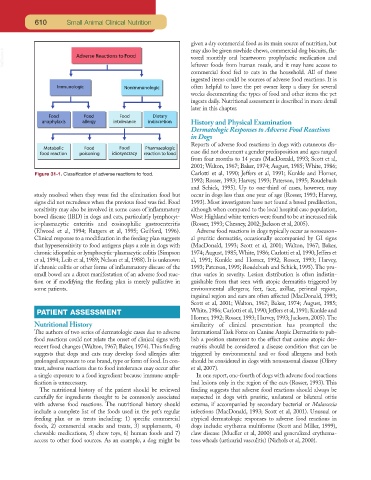Page 588 - Small Animal Clinical Nutrition 5th Edition
P. 588
610 Small Animal Clinical Nutrition
given a dry commercial food as its main source of nutrition, but
may also be given rawhide chews, commercial dog biscuits, fla-
VetBooks.ir vored monthly oral heartworm prophylactic medication and
leftover foods from human meals, and it may have access to
commercial food fed to cats in the household. All of these
ingested items could be sources of adverse food reactions. It is
often helpful to have the pet owner keep a diary for several
weeks documenting the types of food and other items the pet
ingests daily. Nutritional assessment is described in more detail
later in this chapter.
History and Physical Examination
Dermatologic Responses to Adverse Food Reactions
in Dogs
Reports of adverse food reactions in dogs with cutaneous dis-
ease did not document a gender predisposition and ages ranged
from four months to 14 years (MacDonald, 1993; Scott et al,
2001; Walton, 1967; Baker, 1974; August, 1985; White, 1986;
Figure 31-1. Classification of adverse reactions to food. Carlotti et al, 1990; Jeffers et al, 1991; Kunkle and Horner,
1992; Rosser, 1993; Harvey, 1993; Paterson, 1995; Roudebush
and Schick, 1995). Up to one-third of cases, however, may
study resolved when they were fed the elimination food but occur in dogs less than one year of age (Rosser, 1993; Harvey,
signs did not recrudesce when the previous food was fed. Food 1993). Most investigators have not found a breed predilection,
sensitivity may also be involved in some cases of inflammatory although when compared to the local hospital case population,
bowel disease (IBD) in dogs and cats, particularly lymphocyt- West Highland white terriers were found to be at increased risk
ic-plasmacytic enteritis and eosinophilic gastroenteritis (Rosser, 1993; Chesney, 2002; Jackson et al, 2005).
(Elwood et al, 1994; Rutgers et al, 1995; Guilford, 1996). Adverse food reactions in dogs typically occur as nonseason-
Clinical response to a modification in the feeding plan suggests al pruritic dermatitis, occasionally accompanied by GI signs
that hypersensitivity to food antigens plays a role in dogs with (MacDonald, 1993; Scott et al, 2001; Walton, 1967; Baker,
chronic idiopathic or lymphocytic-plasmacytic colitis (Simpson 1974; August, 1985; White, 1986; Carlotti et al, 1990; Jeffers et
et al, 1994; Leib et al, 1989; Nelson et al, 1988). It is unknown al, 1991; Kunkle and Horner,1992; Rosser, 1993; Harvey,
if chronic colitis or other forms of inflammatory disease of the 1993; Paterson, 1995; Roudebush and Schick, 1995). The pru-
small bowel are a direct manifestation of an adverse food reac- ritus varies in severity. Lesion distribution is often indistin-
tion or if modifying the feeding plan is merely palliative in guishable from that seen with atopic dermatitis triggered by
some patients. environmental allergens; feet, face, axillae, perineal region,
inguinal region and ears are often affected (MacDonald, 1993;
Scott et al, 2001; Walton, 1967; Baker, 1974; August, 1985;
PATIENT ASSESSMENT White,1986; Carlotti et al,1990; Jeffers et al,1991; Kunkle and
Horner, 1992; Rosser, 1993; Harvey, 1993; Jackson, 2005).The
Nutritional History similarity of clinical presentation has prompted the
The authors of two series of dermatologic cases due to adverse International Task Force on Canine Atopic Dermatitis to pub-
food reactions could not relate the onset of clinical signs with lish a position statement to the effect that canine atopic der-
recent food changes (Walton, 1967; Baker, 1974). This finding matitis should be considered a disease condition that can be
suggests that dogs and cats may develop food allergies after triggered by environmental and or food allergens and both
prolonged exposure to one brand, type or form of food. In con- should be considered in dogs with nonseasonal disease (Olivry
trast, adverse reactions due to food intolerance may occur after et al, 2007).
a single exposure to a food ingredient because immune ampli- In one report, one-fourth of dogs with adverse food reactions
fication is unnecessary. had lesions only in the region of the ears (Rosser, 1993). This
The nutritional history of the patient should be reviewed finding suggests that adverse food reactions should always be
carefully for ingredients thought to be commonly associated suspected in dogs with pruritic, unilateral or bilateral otitis
with adverse food reactions. The nutritional history should externa, if accompanied by secondary bacterial or Malassezia
include a complete list of the foods used in the pet’s regular infections (MacDonald, 1993; Scott et al, 2001). Unusual or
feeding plan or as treats including: 1) specific commercial atypical dermatologic responses to adverse food reactions in
foods, 2) commercial snacks and treats, 3) supplements, 4) dogs include: erythema multiforme (Scott and Miller, 1999),
chewable medications, 5) chew toys, 6) human foods and 7) claw disease (Mueller et al, 2000) and generalized erythema-
access to other food sources. As an example, a dog might be tous wheals (urticarial vasculitis) (Nichols et al, 2000).

